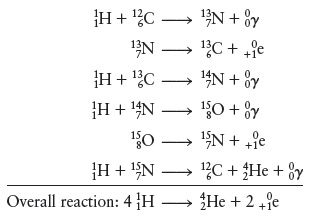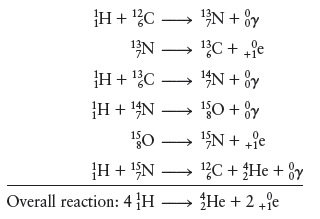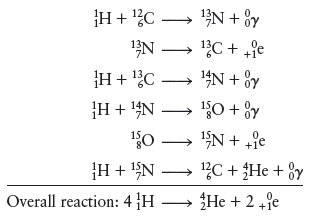
(a)
Interpretation: The catalyst in the below mentioned scheme of the carbon-nitrogen cycle that occurs in the sun, needs to be determined.

Concept Introduction: The carbon-nitrogen cycle which occurs in the sun is a fusion reaction, wherein Hydrogen gets converted into Helium.
(a)
Answer to Problem 70AE
The catalyst in the mentioned scheme of carbon-nitrogen cycle is
Explanation of Solution
Following is the carbon-nitrogen cycle that occurs in the sun:-
The overall reaction is
A catalyst is a substance that influences the speed of a
(b)
Interpretation: The nucleons that are intermediates in the below mentioned scheme of the carbon-nitrogen cycle that occurs in the sun needs to be determined.

Concept Introduction: The carbon-nitrogen cycle which occurs in the sun is a fusion reaction, wherein Hydrogen gets converted into Helium.
(b)
Answer to Problem 70AE
The nucleons that are intermediates in the mentioned scheme are
Explanation of Solution
Following is the carbon-nitrogen cycle that occurs in the sun:-
The overall reaction is
The molecular entity which is evolved from the reactants and will further react in order to give the products, in a chemical reaction, are called as intermediates. In this case, the nucleon intermediates formed are
(c)
Interpretation: The energy that is released per mole of Hydrogen nuclei in the below mentioned scheme of the carbon-nitrogen cycle that occurs in the sun needs to be determined.

Concept Introduction: The carbon-nitrogen cycle which occurs in the sun is a fusion reaction, wherein Hydrogen gets converted into Helium.
(c)
Answer to Problem 70AE
Explanation of Solution
In order to start with, the mass defect
In the Helium atom
The number of neutrons =
The number of electrons = atomic number = 2
The overall reaction is as shown below:-
The above derived is the difference in the mass per nucleus.
Further the energy change
Wherein
Speed of light
Substituting these values in the energy change equation:-
Hence
Further the energy released per mole of
Therefore the energy released per mole of Hydrogen nuclei is
Want to see more full solutions like this?
Chapter 20 Solutions
EBK CHEMICAL PRINCIPLES
- CH, CH CH₂ CH₂ Phytyl side chain 5. What is the expected order of elution of compounds A-D below from a chromatography column packed with silica gel, eluting with hexane/ethyl acetate? C D OHarrow_forwardPlease analze my gel electrophoresis column of the VRK1 kinase (MW: 39.71 kDa). Attached is the following image for the order of column wells and my gel.arrow_forward2.0arrow_forward
- Write the electron configuration of an atom of the element highlighted in this outline of the Periodic Table: 1 23 4 5 6 7 He Ne Ar Kr Xe Rn Hint: you do not need to know the name or symbol of the highlighted element! ☐arrow_forwardCompare these chromatograms of three anti-psychotic drugs done by HPLC and SFC. Why is there the difference in separation time for SFC versus HPLC? Hint, use the Van Deemter plot as a guide in answering this question. Why, fundamentally, would you expect a faster separation for SFC than HPLC, in general?arrow_forwardA certain inorganic cation has an electrophoretic mobility of 5.27 x 10-4 cm2s-1V-1. The same ion has a diffusion coefficient of 9.5 x 10-6cm2s-1. If this ion is separated from cations by CZE with a 75cm capillary, what is the expected plate count, N, at an applied voltage of 15.0kV? Under these separation conditions, the electroosmotic flow rate was 0.85mm s-1 toward the cathode. If the detector was 50.0cm from the injection end of the capillary, how long would it take in minutes for the analyte cation to reach the detector after the field was applied?arrow_forward
- 2.arrow_forwardPlease solve for the following Electrochemistry that occursarrow_forwardCommercial bleach contains either chlorine or oxygen as an active ingredient. A commercial oxygenated bleach is much safer to handle and less likely to ruin your clothes. It is possible to determine the amount of active ingredient in an oxygenated bleach product by performing a redox titration. The balance reaction for such a titration is: 6H+ +5H2O2 +2MnO4- à 5O2 + 2Mn2+ + 8H2O If you performed the following procedure: “First, dilute the Seventh Generation Non-Chlorine Bleach by pipetting 10 mL of bleach in a 100 mL volumetric flask and filling the flask to the mark with distilled water. Next, pipet 10 mL of the diluted bleach solution into a 250 mL Erlenmeyer flask and add 20 mL of 1.0 M H2SO4 to the flask. This solution should be titrated with 0.0100 M KMnO4 solution.” It took 18.47mL of the KMnO4 to reach the endpoint on average. What was the concentration of H2O2 in the original bleach solution in weight % assuming the density of bleach is 1g/mL?arrow_forward
- 10.arrow_forwardProper care of pH electrodes: Why can you not store a pH electrode in distilled water? What must you instead store it in? Why?arrow_forwardWrite the electron configuration of an atom of the element highlighted in this outline of the Periodic Table: 1 23 4 569 7 He Ne Ar Kr Xe Rn Hint: you do not need to know the name or symbol of the highlighted element! §arrow_forward
 ChemistryChemistryISBN:9781305957404Author:Steven S. Zumdahl, Susan A. Zumdahl, Donald J. DeCostePublisher:Cengage Learning
ChemistryChemistryISBN:9781305957404Author:Steven S. Zumdahl, Susan A. Zumdahl, Donald J. DeCostePublisher:Cengage Learning Chemistry: An Atoms First ApproachChemistryISBN:9781305079243Author:Steven S. Zumdahl, Susan A. ZumdahlPublisher:Cengage Learning
Chemistry: An Atoms First ApproachChemistryISBN:9781305079243Author:Steven S. Zumdahl, Susan A. ZumdahlPublisher:Cengage Learning
 Introductory Chemistry: A FoundationChemistryISBN:9781337399425Author:Steven S. Zumdahl, Donald J. DeCostePublisher:Cengage Learning
Introductory Chemistry: A FoundationChemistryISBN:9781337399425Author:Steven S. Zumdahl, Donald J. DeCostePublisher:Cengage Learning Principles of Modern ChemistryChemistryISBN:9781305079113Author:David W. Oxtoby, H. Pat Gillis, Laurie J. ButlerPublisher:Cengage LearningChemistry: Matter and ChangeChemistryISBN:9780078746376Author:Dinah Zike, Laurel Dingrando, Nicholas Hainen, Cheryl WistromPublisher:Glencoe/McGraw-Hill School Pub Co
Principles of Modern ChemistryChemistryISBN:9781305079113Author:David W. Oxtoby, H. Pat Gillis, Laurie J. ButlerPublisher:Cengage LearningChemistry: Matter and ChangeChemistryISBN:9780078746376Author:Dinah Zike, Laurel Dingrando, Nicholas Hainen, Cheryl WistromPublisher:Glencoe/McGraw-Hill School Pub Co





